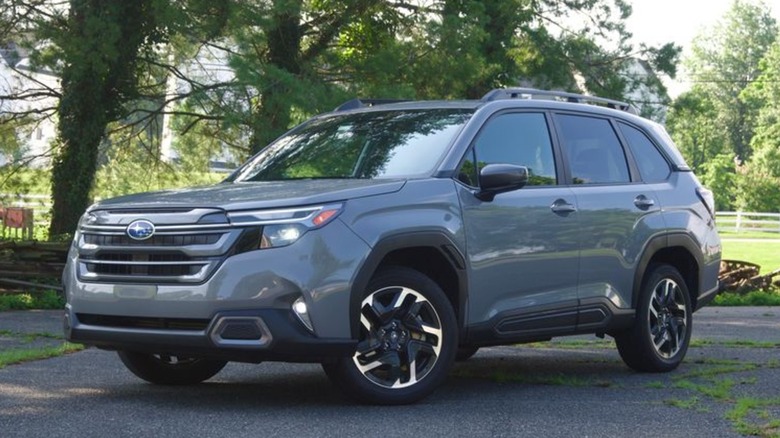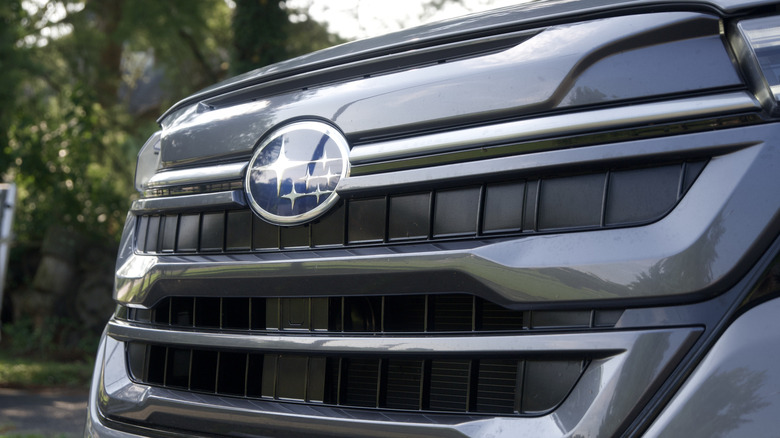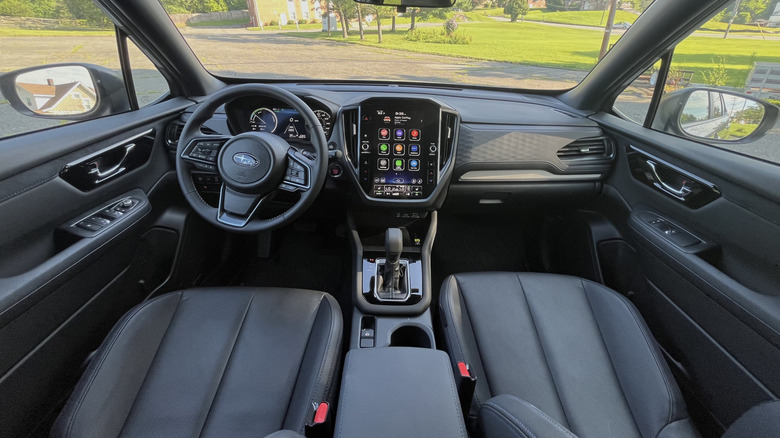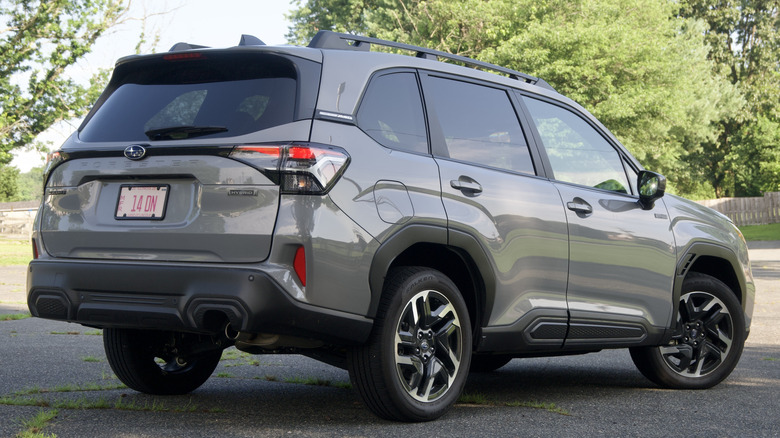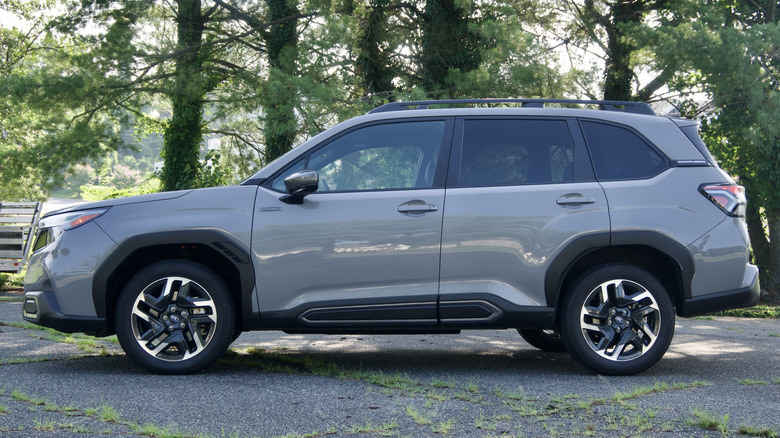2025 Subaru Forester Hybrid Review: Do The MPG Math First
The Subaru Forester is one of the most "Normcore" cars currently on sale today. I don't say that as a bad thing, however. It has decidedly found its audience in the form of families with dogs and people who are about 25% adventurous. Subaru owners are also fiercely loyal, so the automaker doesn't need to try quite as hard to retain drivers. If you own a Subaru now, you're probably just going to continue buying Subarus in the future. The brand is a master at it.
The 2025 Subaru Forester Hybrid, however, is something a little bit different. Not much different mind you, it's still an all-wheel drive SUV that's shaped like a box. But it's just different enough from the rest of Subaru's conventionally internal-combustion powered lineup that I took notice.
It's sometimes a little hard to get excited over a hybrid SUV, especially one that makes under 200 horsepower, but the idea of a more efficient Subaru is rather appealing to a large segment of current owners, not to mention potential new buyers. My mom, a longtime Subaru owner, for example, was actually very interested in seeing a Subie that got more than 30 miles per gallon.
A more efficient Forester
Mechanically, a hybrid option is new to the Forester, but the technology isn't breaking new ground for hybrids in general. It uses the time-tested method of combining an internal combustion engine, a battery, and electric motors to make the overall driving experience more efficient. In this case, the 2.5-liter flat-four and electric motors work together with a CVT to make 194 horsepower.
Subaru notes that its a 14 horsepower boost from the base model Forester, which isn't a ton, but it's better than nothing. All of that combines to give the hybrid Forester a 35 miles per gallon (mpg) rating on the EPA's combined test cycle. The regular Forester gets 29 mpg on the same test. The real gain, though, is with city milage: there, the hybrid gets 35 mpg, compared to the non-hybrid's 26 mpg. Again, not a lot better, but better than nothing.
Actually driving and living with the Forester Hybrid felt exactly the same as every other Subaru I've ever driven/owned/reviewed. It's not particularly exciting, but it's capable and does what it says on the box. Over the course of the week, I took the Forester out to run errands, went on a few longer jaunts on the highway, and, of course, whipped around a wet parking lot. Subaru is the poster child for unobtrusive all-wheel drive and the Forester is no different. It's competent in sketchy weather (there were a number of nasty thunderstorms during my week of testing, accompanied with some flooding), and I never felt like the car was going to be unpredictable. I suspect that's because the car doesn't have a lot of power to begin with, and Subarus have been equipped with all-wheel drive systems as standard on nearly every car for about 40 years, so the brand knows what it's doing.
Starlink Woes
The interior is exactly the same as in other Subaru models like the Crosstrek and Outback that I've driven. Even in the Limited trim, it's not extremely luxurious, but it gets the job done. It's not distractingly sparse or lacking in any features, but it's no Mercedes-Benz. Where the Forester shines is utility. You can fit a lot of stuff and it won't ever complain. I used every bit of the Forester's 69.1 cubic feet of cargo room over the course of the week, including loading a lawn mower into the back. Occasionally, hybrid models you sacrifice cargo space as the automaker needs to find somewhere to put the battery. This is not the case with the Forester as that 69.1 cubic feet of maximum capacity is shared with the rest of the Forester range. That's pretty impressive.
My issues with the 2025 Forester Hybrid are, unfortunately, the same issues I have with a lot of other Subarus. Starlink, the automaker's infotainment system, is an outright pain to use. It pretty regularly forgot my phone existed and it was a confusing mess of a process to get it to pair again, sometimes necessitating my turning the car off and back on to get it to work. There was almost no rhyme or reason to the system crashing or otherwise ceasing to work. It was maddening.
Pricing up the hybrid
Subarus are not known to be particularly expensive cars, and this 2025 Forester Limited Hybrid isn't any different. It has a sticker price of $41,010 (before $1,420 destination), which is a $3,315 premium over the non-hybrid Forester Limited's $37,695. The least expensive electrified Forester, the Premium Hybrid, starts at $36,595 (or $3,210 more than the non-hybrid version of the Forester Premium).
As tested, the 2025 Subaru Forester Limited Hybrid I drove was equipped with an 11 speaker Harmon Kardon sound system, 8.7 inches of ground clearance, Subaru's EyeSight driver monitoring and driver assistance technology, some faux wood accents, rear cross traffic alert, a 10-way power driver seat, 18-inch wheels, and a power liftgate. The sole optional extra was the paint color: River Rock Pearl, at $395. With destination it came to $42,825, which is fairly reasonable for a full-featured hybrid five-seater SUV.
Comparing it to the competition, cars like the Toyota RAV4 Hybrid start out less expensive, but higher up trims start to be pretty comparable with the RAV4 Hybrid Limited starting at $40,905 minus the destination charge. Where the Toyota wins out is fuel economy, reaching into the 40s for city mileage. Honda's Hybrid CR-V is similar, with the Sport-L Hybrid retailing for $38,725 before destination and carrying a 40 mpg city rating.
2025 Forester Hybrid Verdict
When it comes to other hybrid SUVs, the Forester Hybrid isn't the best deal out there. If your only goal is to save money on gas, then a RAV4 or CR-V might be a better bet. However, given the aforementioned loyalty of Subaru fans, if you are looking to upgrade your current Forester, opting for the hybrid drivetrain is almost a no brainer. You don't gain much in the terms of excitement, but you don't lose much either. The hybrid system is just flat out better than the base model's drivetrain in all the ways that matter.
The EPA estimates — based on 15,000 annual miles at current fuel prices, with 45% on the highway and 55% in the city — that Forester Hybrid drivers will spend $1,400 a year on fuel, versus $1,650 for the equivalent non-hybrid. That means it could take almost 13 years of gas savings to balance out the greater vehicle purchase price, though the electrified Forester's markedly better city economy does mean that predominantly urban drivers should see that balance achieved sooner.
No one ever claimed that the Subaru Forester was the most fun car you will ever drive, so I'm not going to bash it for being a little staid. Overall, I enjoyed what Subaru did to its popular SUV: massaging some savings out via the hybrid system, assuming you're driving enough to balance out the greater sticker price with lower fuel costs. Now, if Subaru could figure out how to make Starlink more usable, then it might have a real winner in the field of hybrids on its hands.
